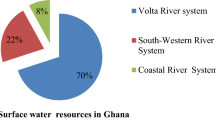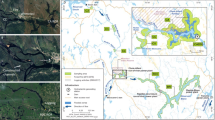Abstract
Reservoirs have a wide variety of uses that have led to frequent conflicts over ecological conservation and contamination, especially as land management has intensified. Oligotrophication must be implemented in numerous tropical reservoirs that experience advanced eutrophication to maintain aquatic ecosystem functions. To quantify impacts on ecosystem functions and to develop an adaptive management policy, multiple studies have been conducted on the Itaparica Reservoir, São Francisco River, in the semi-arid north-eastern region of Brazil. Here, we add to that existing body of knowledge through investigating how nutrient accumulation is affected by water exchange between the main river flow and Icó-Mandantes Bay. Operational water-level fluctuations in the reservoir create large desiccated littoral areas that release high amounts of nutrients when they are rewetted. In particular, water-level variation promotes proliferation of Egeria densa, a noxious weed, thus elevating trophic levels of the Itaparica Reservoir and Icó-Mandantes Bay. Analysis with a P efficiency model determined 25 μg P L−1 to be the critical concentration and further indicated that the critical load in both bodies of water have been exceeded. Moreover, intensive fish aquaculture using net cages has led to further overtaxing of the reservoir. We conclude that an effective ecological reservoir management policy must involve oligotrophication, harvesting of noxious water weeds for use as soil amendment in agriculture or biogas production, “blue” aquaculture, and limiting hydroelectric power production based on current water availability.





Similar content being viewed by others
References
Abril G, Guérin F, Richard S, Delmas R, Galy-Lacaux C, Gosse P, Tremblay A, Varfalvy L, Dos Santos MA, Matvienko B (2005) Carbon dioxide and methane emissions and the carbon budget of a 10-years old tropical reservoir (Petit Saut, French Guiana). Glob Biolgeochem Cycles 19. https://doi.org/10.1029/2005GB002457
ANA (2015) Encarta Especial sobre a Crise Hídrica. Agência Nacional de Águas, Brasília, p 30
Andrade e Santos H, Pompea PS, Kenji DOL (2012) Changes in the flood regime of São Francisco River (Brazil) from 1940 to 2006. Reg Environ Chang 12:123–132. https://doi.org/10.1007/s10113-011.0240-y
Aragão-Tavares NKC, Severiano JS, Moura AN (2015) Phytoplankton composition of the Itaparica and Xingó reservoirs, São Francisco River, Brazil. Brazilian Journal of Biology 75(3):616-627. https://doi.org/10.1590/1519-6984.19413
Bakker ES, Hilt S (2015) Impact of water-level fluctuations on cyanobacterial blooms: options for management. Aquat Ecol 50:485–498. https://doi.org/10.1007/s10452-015-9556-x
Baptista MG, Nixdorf B (2014) Low disturbances favor steady state: case of cyanobacterial monodominance on a Brazilian coastal lagoon. Inland Waters 4:243–254. https://doi.org/10.5268/IW-4.2.648
Bastien J, Demarty M, Tremblay A (2011) CO2 and CH4 diffusive and degassing emissions from 2003 to 2009 at Eastmain 1 hydroelectric reservoir, Québec, Canada. Inland Waters 1:113–123. https://doi.org/10.5268/IW-1.2.349
Bostock J, McAndrew B, Richards R, Jauncey K, Telfer T, Lorenzen K, Little D, Ross L, Handisyde N, Gatward I, Corner R (2010) Aquaculture: global status and trends. Phil Trans R Soc B 365:2897–2912. https://doi.org/10.1098/rstb.2010.0170
Boyd J, Banzhaf S (2007) What are ecosystem services? The need for standardized environmental accounting unit. Ecol Econ 63:616–626. https://doi.org/10.1016/j-.ecolecon.2007.01.002
Brazil (1997) Da política nacional de recursos hídricos. LeiN° 9.433, de 8 de Janeiro 1997. Institui a Política Nacional de Recursos Hídricos
Carrillo Y, Guarín A, Guillot G (2006) Biomass distribution, growth and decay of Egeria densa in a tropical high-mountain reservoir (NEUSA, Colombia). Aquat Bot 85:7–15. https://doi.org/10.1016/j.aquabot.2006.01.006
Casper P, Chan OC, Furtado ALS, Adams DD (2003) Methane in an acidic bog lake: the influence of peat in the catchment on the biogeochemistry of methane. Aquat Sci 65:36–46. https://doi.org/10.1007/s000270300003
Castro CNDC (2011) Transposição Do Rio São Francisco: Análise De Oportunidade Do Projeto. IpeaGovBr
CONAMA (2005) Resolution n 357, de 17 de Março de 2005 Diário Oficial da Republica Federativa do Brasil. Brasília, DF
Coutinho RM, Kraenkel RA, Prado PI (2015) Catastrophic regime shift in water reservoirs and São Paulo water supply crisis. PLoS One 10:e0138278. https://doi.org/10.1371/journal.pone.0138278
DEV (2018) Deutsche Einheitsverfahren zur Wasser-, Abwasserund Schlammuntersuchung. VCH, Weinheim, Loseblattsammlung 2015:39–40. https://doi.org/10.1002/lipi.19950970113
Döll P, Hauschild M (2002) Model-based scenarios of water use in two semi-arid Brazilian states. Reg Environ Chang 2:150–162. https://doi.org/10.1007/s10113-002-0046-z
FADURPE (2011) Inventário dos Ecossistemas Aquáticos do Baixo São Francisco Reservatório de Itaparica. 1° - 3°. Relatório Anual. Fundação Apolônio Salles de Desenvolvimento Educacional, Recife, PE
FAO (2016) National Aquaculture Legislation Overview (NALO). www.fao-org/fishery/collection/nalo/en. Access 21.08.2016
Gunkel G (2009) Hydropower—a green energy? Tropical reservoirs and greenhouse gas emissions. CLEAN, Soil, Air, Water 37:726–734. https://doi.org/10.1002/clen.200900062
Gunkel G (2018a) Água no Contexto das Bacias Hidrográficas: Qualidade, contaminação e monitoreamento. In: Philippi Jr A and Sobral MC (eds.) Direito Ambiental, vol 4. Gestão Sustentável Bacias Hidrográficas. Embrapa, Brasilia, Brazil, in press
Gunkel G (2018b) Manejo das Bacias Hidrográficas: Servicios ecossistemas e tecnologias avançadas In: Philippi Jr A & Sobral MC (eds.) Direito Ambiental, vol 4. Gestão Sustentável Bacias Hidrográficas. Embrapa, Brasilia, Brazil, in press
Gunkel G, Sobral M (2007) Reservoirs and river basins management: exchange of experience from Brazil, Portugal and Germany. Universitätsverlag der TU Berlin, Berlin, pp 279
Gunkel G, Sobral M (2013) Re-oligotrophication as a challenge for tropical reservoir management with reference to Itaparica Reservoir, São Francisco, Brazil. Wat Sci Technol 67(4):708–714. https://doi.org/10.2495/RBM130261
Gunkel G, Silva JA, Sobral MC (2013a) Sustainable management of water and land in semiarid areas. Editora Universitária UFPE, Recife, pp 295
Gunkel G, Steemann J, Sobral MC (2013b) Carrying capacity limits in net cage fish production in water reservoirs. In: Gunkel G, Silva JA, Sobral MC (eds) Sustainable management of water and land in semiarid areas. Editora Universitária UFPE, Recife, pp 99–117
Gunkel G, Lima D, Selge F, Sobral M, Calado S (2015a) Aquatic ecosystem services of reservoirs in semi-arid areas: sustainability and reservoir management. WIT Trans Ecol Environ 197:187–200. https://doi.org/10.2495/RMI50171
Gunkel G, Matta E, Selge F, Nogueira da Silva GM, Sobral M (2015b) Carrying capacity limits of net cage aquaculture for Brazilian reservoirs. Rev Bras Cienc Ambientais 36:127–144. https://doi.org/10.5327/z2176
Halide H, Stigebrandt A, Rehbein M, McKinnon AD (2009) Developing a decision support system for sustainable cage aquaculture. Environ Model Softw 24:694–702. https://doi.org/10.1016/j.envsoft.2008.10.013
Huszar VLM, Caraco NF, Roland F, Cole J (2006) Nutrient-chlorophyll relationships in tropical-subtropical lakes: do temperate models fit? Biogeochemistry 79:239–250. https://doi.org/10.1007/s10533-006-9007-9
INNOVATE (2016). Interplay among multiple uses of water reservoirs via innovative coupling of substance cycles in aquatic and terrestrial ecosystems. http://www.innovate.tu-berlin.de/. Accessed 26 July 2016
IPCC (2014) Central and South America. In: IPCC (ed) Climate Change 2014: Impacts, Adaptation, and Vulnerability. Part B: Regional Aspects. Contribution of Working Group II to the Fifth Assessment Report of the Intergovernmental Panel on Climate Change. Cambridge University Press, Cambridge, United Kingdom and New York, pp 1499–1566
Lima D, Gunkel G (2018) Egeria densa, a noxious weed, as a challenge for hydropower reservoir management. Lakes & Reservoirs: Research and Management
Keitel J, Zak D, Hupfer M (2016) Water level fluctuations in a tropical reservoir: the impact of sediment drying, aquatic macrophytes dieback, and oxygen availability on phosphorus mobilization. Environ Sci Pollut Res 23:6883–6894. https://doi.org/10.1007/s11356-015-5915-3
King J, Brown C, Sabet H (2003) A scenario-based holistic approach to environmental flow assessment for rivers. River Res Applic 19:619–639. https://doi.org/10.1002/rra.709
MacIntyre S, Wanninkhof R, Chanton JP (1995) Trace gas exchange across the air-water interface in freshwater and costal marine environments. In: Matson PA, Harris RC (eds) Biogenic trace gases: measuring emissions from soil and water. Blackwell science, Cambridge, pp 52–97
Matta E, Selge F, Gunkel G, Rossiter K, Jourieh A, Hinkelmann R (2016) Simulations of nutrient emissions from a net cage aquaculture system in a Brazilian bay. Water Sci Technol 73:2430–2435. https://doi.org/10.2166/wst.2016.092
Matta E, Selge F, Gunkel G, Hinkelmann R (2017) Three-dimensional modeling of wind- and temperature-induced flows in the Icó-Mandantes bay, Itaparica reservoir, NE Brazil. Water 9:772. https://doi.org/10.3390/w9100772
MMA (2005) Instrução Normativa Interministerial No 7. Gabinete da Ministra instrução normativa interministerial, de 28 de Abril de 2005. Ministra de Estado do Meio Ambiente DOU29.04.2005
Mosley LM (2015) Drought impacts on the water quality of freshwater systems; review and integration. Earth Sci Rev 140:203–214. https://doi.org/10.1016/j.earscirev.2014.11.010
Nair P, Logan T, Sharpley A, Sommers L, Tabatabai M, Yuan T (1984) Interlaboratory comparison of a standardized phosphorus adsorption procedure. J Environ Qual 13:591–595. https://doi.org/10.2134/jeg1984.00472425001300040016x
Ometto JP, Pacheco FS, Cimbleris ACP, Stech JL, Lorenzzetti JA, Assireu A, Santos MA, Matvienko B, Rosa LP, Galli CS, Abe DS, Tundisi JG, Barros NO, Mendonça RF, Roland F (2012) Carbon dynamic and emissions in Brazilian hydropower reservoirs. In: deAlcantara EH (ed) Energy resources: development, distribution and exploitation. Nova Science Publishers, Inc, Hauppauge, pp 155–188
Reyer CPO, Adams S, Albrecht T, Baarsch F, Boit A, Trujillo NC, Carlsburg M, Coumou D, Eden A, Fernandes E, Marcus R, Mengel M, Mira-Salama D, Perette M, Pereznieto P, Rammig A, Reihhardt J, Robinson A, Rocha M, Sakschwewski B, Schaeffer M, Schleussner C-F, Serdeczny O, Thonicke K (2017) Climate change impacts in Latin America and the Caribbean and their implications for development. Reg Environ Chang 17:1601–1621. https://doi.org/10.1007/s10113-015-0854-6
Rodriguez M, Casper P (2013) Carbon cycling and greenhouse gas emissions. In: Gunkel G, Silva JA, Sobral MC (eds) Sustainable management of water and land in semiarid areas. Editora Universitaria UFPE, Recife, pp 79–98
Rodriguez M, Casper P (2018) Green house gases emissions from a semi-arid reservoir in Northeast Brazil. Reg Environ Change. https://doi.org/10.1007/s10113-018-1289-7
Selge F (2017) Aquatic ecosystem functions and oligotrophication potential of the Itaparica reservoir, São Francisco river, in the semi-arid Northeast Brazil. ITU Schriftenreihe Nr. 33, Papierflieger Verlag, Clausthal-Zellerfeld, p 141
Selge F, Hagel H, Gunkel G, Doluschitz R (2015) Annual rainfall variability and economic dependency of smallholder agriculture in the semi-arid Northeast Brazil. Revista Brasileira Ciencias Ambientais 36:145–156. https://doi.org/10.5327/z2176
Selge F, Matta E, Hinkelmann R, Gunkel G (2016) Nutrient load concept-reservoir vs. bay impacts: a case study from a semi-arid watershed. Water, Sci Technol 74(7):1671–1679. https://doi.org/10.2166/wst.2016.342
Snow A, Anderson B, Wootton B (2012) Flow-through land-based aquaculture wastewater and its treatment in subsurface flow constructed wetlands. Environ Rev 20:54–69. https://doi.org/10.1139/A11-023
Suen JP, Eheart JW (2006) Reservoir management to balance ecosystem and human needs: incorporating the paradigm of the ecological flow regime. Water Resour Res W03417. https://doi.org/10.1029/2005WR004314
Turner BL, Haygarth PM (2001) Phosphorus solubilization in rewetted soils. Nature 411:258. https://doi.org/10.1038/35077146
Velini ED, Corrêa MR, Tanaka RH, Bravin LF, Antuniassi UR, Carvalho FT, Galo MLBT (2005) Avaliação operacional do controle mecânico de plantas aquáticas imersas no reservatório de Jupiá. Planta Daninha, Viçosa-MG 23:277–285. https://doi.org/10.1590/S0100-8358
VLStL, Kelly CA, Duchemin É, Rudd JWM, Rosenberg DM (2000) Reservoir surface as sources of greenhouse gases to atmosphere: a global estimate. Bioscience 50:766–775. https://doi.org/10.1641/0006-3568(2000)050[0766:RSASOG]2.0.CO;2
Vollenweider R, Kerekes J (1982) Eutrophication of waters: monitoring, assessment, and control. OECD, Paris
Wehrli B (2011) Climate science: renewable but not carbon-free. Nat Geosci 4:585–586. https://doi.org/10.1038/ngeo1226
Yarrow M, Marin VH, Finlayson M, Tironi A, Delgado LE, Fischer F (2009) The ecology of Egeria densa Planchon (Liliopsida: Alismatales): a wetland ecosystem engineer. Rev Chil Hist Nat 82:299–313
Acknowledgments
The study reports data from the CHESF monitoring program conducted during 2007–2010 by the FADURPE and the INNOVATE project.
Funding
The binational INNOVATE project is funded by the German Federal Ministry of Education and Research (BMBF), the Brazilian Conselho Nacional de Desenvolvimento Científico e Tecnológico (CNPq), the Ministério da Ciência, Tecnologia e Inovação (MCTI), and the Universidade Federal de Pernambuco (UFPE).
Author information
Authors and Affiliations
Corresponding author
Rights and permissions
About this article
Cite this article
Gunkel, G., Selge, F., Keitel, J. et al. Water management and aquatic ecosystem services of a tropical reservoir (Itaparica, São Francisco, Brazil). Reg Environ Change 18, 1913–1925 (2018). https://doi.org/10.1007/s10113-018-1324-8
Received:
Accepted:
Published:
Issue Date:
DOI: https://doi.org/10.1007/s10113-018-1324-8




